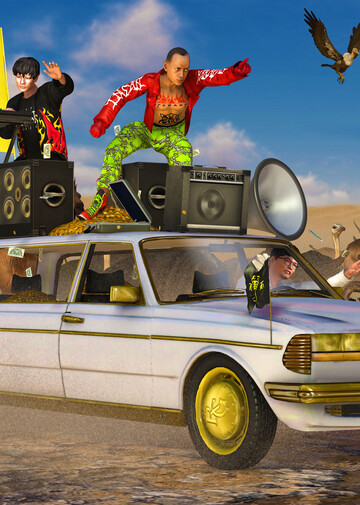
No Dancing Allowed
Opening
Tue 21.06., 19hExhibition
22.06. – 20.11.2022Opening hours
Tue-Sun 13-19hAdmission
freePress Tour: Tue, 21.06., 10h
Opening: Tue 21.06., 19h
Performance YOKHOR by Natalia Papaeva: 19.30h
Performance OTION: 20h
DJ set by Authentically Plastic: 20.30 - 22h
Film Program @ frame[o]ut Festival: Fr 15.07., 21.30h
Venue: MQ Main courtyard (in case of bad weather: Arena 21)
feat. films by KAMVA collective, Yarema Malashchuk & Roman Himey, Gabber Modus Operandi & Rimbawan Gerilya
Details: here
ORF Long Night of Museums: Sat 01.10.
Exhibition open from 13 - 1h, admission free
Anton Shebetko: A Very Brief and Subjective Queer History of Ukraine: Tue 18.10., 17.30h
Artist-in-Residence Anton Shebetko in conversation with Julius Pristauz, Moderation: Elisabeth Hajek, Artistic Director frei_raum Q21
Book presentation and Artist Talk at Buchhandlung Walther König im MuseumsQuartier Wien
Julius Pristauz: THE PENETRATION OF MULTIPLE SPACES: Sat 19.11., 18–18.30h
Ania Nowak: To the Aching Parts! (Manifesto): Sat 19.11., 18.45–19h
Performances as part of Vienna Art Week in the frei_raum Q21
Artists:
Authentically Plastic* & Keith Zenga King, Colectivo LASTESIS, Nick Coutsier, Jeremy Deller, EMIRHAKIN*, Escape 010101 | Yannet Vilela & Jesper Frederiksen, Lucia Fernandez Santoro*, Gabber Modus Operandi & Rimbawan Gerilya, KAMVA Collective* | Chris Kets & Amílcar Patel, Adriana Knouf, Vera Logdanidi*, Luiz Felipe Lucas*, Yarema Malashchuk & Roman Himey, Clémence Mira*, Ania Nowak*, Nude Robot, Nyege Nyege, OTION*, Natalia Papaeva*, Julius Pristauz, Shanghai Community Radio, Anton Shebetko*, Space of Urgency* & Jan Beddegenoodts & Maximilian Mauracher, Spiral Tribe | Mark Angelo Harrison*, Maša Stanić, Paula Strunden, Olga Udovenko (Udda)*, United We Stream, Bambi van Balen* | TOOLS FOR ACTION, Liam Young, #FreeBritney
*Q21 Artist-in-Residence
Curator:
Bogomir Doringer
After sudden isolation struck like sunrise to an over-dilated eye, a new and uncertain world seeped into focus. Dance and uncertainty are by no means strangers: congregation and movement when in response to personal and collective crises, becoming a dance of urgency. Such a dance aims to empower the individual and the group—it builds communities of survival and coping; it can perform as a powerful agent of urban renewal and political resistance*. From cultural spaces reinvigorating decaying neighborhoods to international protests against gentrification and fascism—dance is the weather of the cultural and political climate and a potent form of defiance. Though, when a medium is so dependent on presence and closeness—how does it manifest over enforced distances? What did it mean to you once dance was not allowed?
Far from dissolving, dance migrated to digital networks— navigating new formal boundaries and visual languages in the process. From pop star Britney Spears’s SOS encoded dance feeding the #FreeBritney movement to family dance battles over Zoom; dance (having been determined a health hazard) unbound itself to place and geography—re-materialising itself online. Zoom, virtual reality, TikTok and an evergrowing assembly of social media platforms became vital means of participation and cultural production.
During the pandemic governments were granted new powers of surveillance—some taking oppressive measures to crack down on protest rights under the guise of national health measures. This most greatly impacted vulnerable communities, whose right to assembly was threatened. On top of this many gathering spaces were left without financial support—deemed “non-essential”, “for entertainment”, or “culturally insignificant”. In response, communities rallied to self-organize online and eventually—in public space. This new state solicited new questions: can protest, outcry and resistance against oppressive governments keep momentum under these circumstances? Further, can dance offer us the tools to destabilize the ones created to coerce and surveil us?
As tragic as it was dynamic, this has been a period of significant loss—of life, intimacy, expression and language itself. These new voids haunt: fragmented bonds, loss of freedom, social unrest and death silhouetting themselves against celebrations of survival. Calling some to violate the rules—illegal raves performing as a kind of “danse macabre” in acceptance of risk and death, or demonstrating escapism as emotional self-care. Almost entirely produced during the pandemic, No Dancing Allowed maps and bears these contradictions—integrating recent history with these last three years, it asserts dance and dance spaces as entities whose transformational nature grant us the power to thrive in times of great adversity—and bravely reemerge.
* Encountering club culture and dancing as a form of protest during the NATO bombing of Doringer’s native Serbia, he discovered how socio-political instability and collective coping mechanisms of movement are linked. Sparking a research investigation and later a PhD at the University of Applied Arts Vienna—providing dance culture knowledge since 2014. It is a continuation of the online events that happened during lockdowns, in cooperation with the department of ‘Social Design—Arts as Urban Innovation’ of the University of Applied Arts Vienna.
Exhibition display: Michael Hofer-Lenz, student of the Department of Stage and Costume Design, Film and Exhibition Architecture, University Mozarteum Salzburg
Exhibition partner: MU Hybrid Art House, Eindhoven
Creative Producer: Rafael Kozdron
Text by: Matthew JP Sturt-Scobie, Bogomir Doringer
Graphic Design: Michael Rudolph
Image © Gabber Modus Operandi & Rimbawan Gerilya